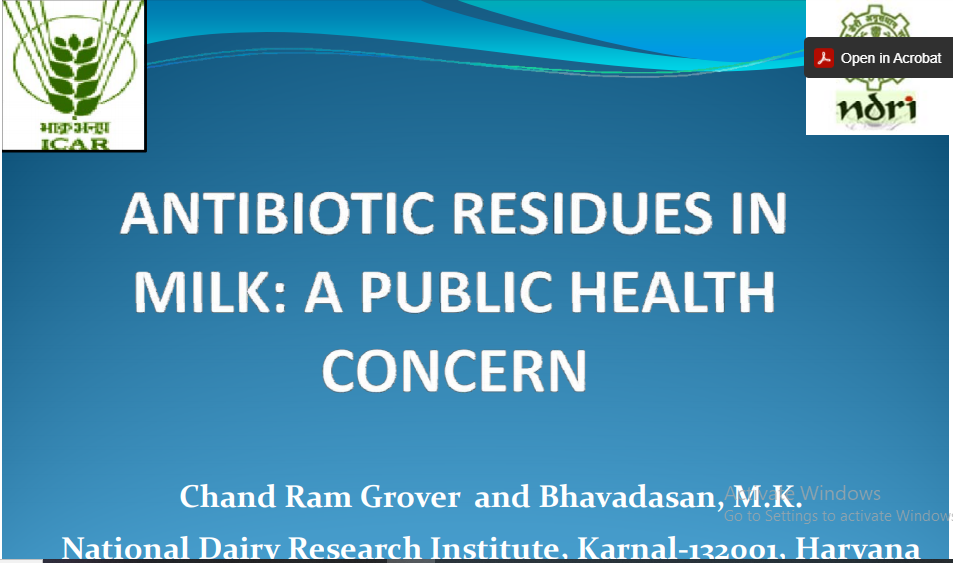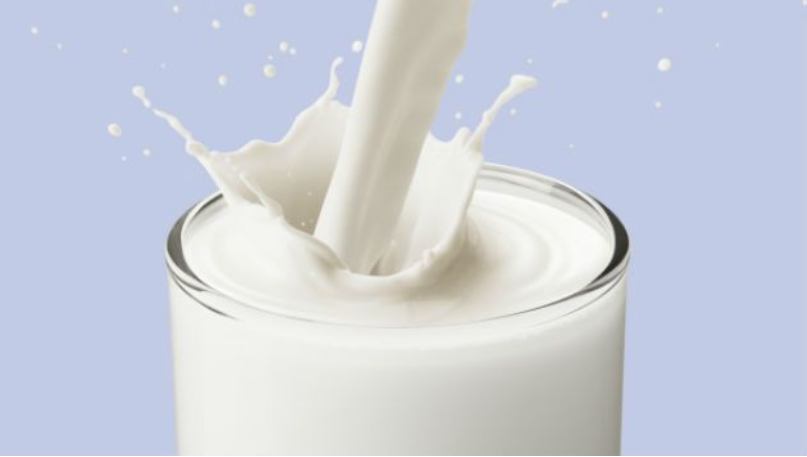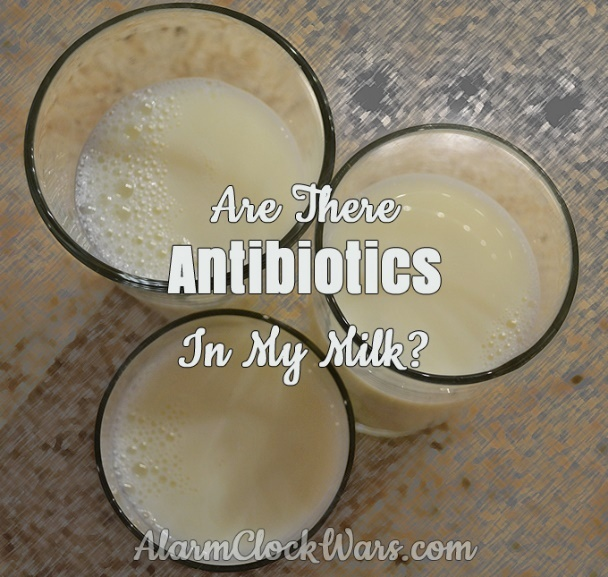Antibiotic Residues in milk and milk products
Back
MILK:
Milk a highly perishable commodity is susceptible to contamination:
Pesticides
Toxic heavy metals
Myco‐toxins, antibiotics and other veterinary drugs
Microorganisms:
SIGNIFICANCE OF ANTIBIOTICS IN MILK AND MILK PRODUCTS
Why public is concerned about antibiotics
Public health:
Allergic reaction
Toxicity
Hypersensitivity
Carcinogens/ mutagens
Alter gastrointestinal micro‐flora
Food should be completely antibiotic free
ANTIMICROBIAL USE IN ANIMALS: EFFECTS ON ANTIBIOTIC RESISTANCE EMERGENCE
The problem of antimicrobial resistance knows no boundaries.
Drug‐resistant microbes of all kinds can move among people and animals, from one country to
another—without notice.
The threat of antibiotic resistance is growing at an alarming pace, perhaps more rapidly in
developing countries.
Reasons of antibiotic resistance threat among bacteria than other microorganism:
The abuse of antibacterial drugs is much higher than that of antifungal or antiviral agents; the later ones are seldom self‐prescribed, wrongfully used as prophylaxis, or have agricultural usage;
Much more abundant than viruses, fungi, and protozoa as microbiota of humans, which increases exponentially the exposure of the former to antibiotics each time they are used clinically, creating more chances of resistance to emerge and be selected;
Bacterial diseases are also more abundant, at least for treatment purposes, increasing also the exposure to antibacterial drugs, perhaps with the exception of malaria.

F1rst is a business research and consulting firm specializing in food and beverage ingredients, based in India with a global footprint. As part of its academia outreach services, a survey was conducted in five different cities, including Ahmedabad, Bengaluru, Delhi, Hyderabad, and Mumbai to test the prevalence of antibiotic residues in milk. The prevalence of antibiotics residues was found to be higher in Delhi (100%), Ahmedabad (60%), Hyderabad (20%), followed by Bengaluru (10%) and Mumbai (10%).

Improper drug usage
Out of 10 samples collected in each city for five days continuously, Ahmedabad and Delhi showed higher levels of antibiotic residue prevalence. Prevalence is calculated based on the number of milk samples showing positive above the tolerance limit ranging from 10µg/L of different antibiotics for minimum one day during the survey period of five days.
Babies can’t digest cow milk as easily as breast milk and when it contains antibiotics it may lead to antibiotic resistance, said Dr. S. Balamurugan, Vice president of Indian Academy of Pediatrics, Tamil Nadu.
Moreover, if the milk is “containing antibiotics which may lead to antibiotic resistance to babies (it may) also complicate and prove difficult to give appropriate antibiotics to babies,” he said in an interview. “So, starting cow’s milk after a year is advised mostly.”
Antibiotics residues arise from drugs that are administered to the animals and unintentionally get into the milk they produce.
If a batch of liquid milk contains antibiotics at a level above the tolerance limit of 10µg/L of milk, then it has to be rejected. Some of the dairy processors or small-scale milk producers ignore these tests. This is either due to the lack of awareness of the implications or considering this quality check as unnecessary for liquid or pouch milk-processing, according to the F1rst study.
Awareness
An initial survey conducted by F1rst had shown a higher prevalence of β-lactams (beta-lactam) and tetracycline class of antibiotics in the milk samples from the retail markets in five selected cities in India. This highlights the need to build awareness on proper antibiotics usage in livestock, mainly cows, to treat mastitis.
Consumer concerns
There is a need for vigilant control and monitoring of antibiotics and self-compliance, Good Husbandry Practices and Hazard Analysis and Critical Control Points, according to the F1rst study. Creating awareness among the stakeholders is vital to implement new regulations and standards towards the importance of handling antibiotics.
Dairy farmers and para-vets should be trained for proper use of antibiotics and sensitised to prevent OTC drug purchase and administration of antibiotics to cattle.
The study conducted with an aim to determine the occurrence of antibiotic residues; enrofloxacin, oxytetracycline, penicillin G, sulphamethoxazole and chloramphenicol as well as mycotoxins; aflatoxin M1 and ochratoxin A in raw milk samples collected from individual animals from dairy farms located in 9 districts of Punjab, India.
A total of 168 raw milk samples were collected and analysed using commercially available competitive Enzyme linked immunosorbent assay kits.
Out of these, 19 (11.3%) and 9 (5.4%) samples were found positive for antibiotic residues and mycotoxins, respectively.
The milk samples were positive for enrofloxacin (4.8%), oxytetracycline (3.0%), penicillin G (3.0%) and sulphamethoxazole (0.6%) residues.
The percentage of samples found above maximum residue limit established by Europen Union (EU)/Codex Alimentarius Commission (CAC) were 1.7%, 1.2% and 0.6% for enrofloxacin, oxytetracycline and penicillin G residues, respectively.
Aflatoxin M1 was detected in 5.4% of monitored milk samples with 1.2% samples exceeded the established maximum levels of EU but were below the maximum levels established by CAC.
The occurrence of antibiotic residues and mycotoxins in raw milk samples above maximum limits is a rising concern for food safety due to possibility of health risks to the consumers.
ARE THERE ANTIBIOTICS IN MILK?

ANTIBIOTICS IN MILK
Some brands of milk are popping up with a label that says “no antibiotics” or “antibiotic free” or “all milk is tested for antibiotics.” That’s great – we all want antibiotic free milk. And these labels make it sound like their milk is the only milk that has no antibiotics. But did you know, regardless of what the labels say, that all milk is antibiotic free?
If cows get sick, sometimes they need antibiotics. Not every sick cow needs antibiotics – veterinarians help farmers decide which cows to treat with antibiotics and which cows to treat another way. Just like in people – every time you get sick you don’t need antibiotics, but when you do, antibiotics are really important!
If a cow is given antibiotics, her farmer keeps detailed records about which antibiotic she was given, how much, when, and how often. She is taken out of the milking herd, and her milk is thrown away the entire time she is on antibiotics, and for a certain period of time after the antibiotics are done. This is called the withdrawal period.
WHAT IS THE WITHDRAWAL PERIOD FOR ANTIBIOTICS, AND WHY DOES IT MATTER?
Every medicine that is given to animals, including antibiotics, has a withdrawal period. Farmers must follow these withdrawal times to be sure no antibiotics are in our food.
WHAT IS THE WITHDRAWAL PERIOD?
When a person or an animal is given an antibiotic, it goes to work in the body. The antibiotic does its job killing bacteria, and the body does its job breaking down the antibiotic. This break down takes different times for different antibiotics. It also takes different times in different animals (cows compared to pigs, for example). Some antibiotics have different break down times for different tissues (milk, meat, or liver for example).
The time it takes the body to break down the antibiotic until it is no longer functional or present is called the withdrawal time (or withdrawal period). Once the withdrawal period has passed the antibiotic has been eliminated from the animal’s system.
Every antibiotic has a withdrawal period. Some withdrawal periods are very short, 1 or 2 days. Some are longer, 7-10 days. Some are even longer, up to weeks.
The withdrawal period must be determined for every species of animal the antibiotic can be used on. If the antibiotic can be used in a lactating (milking) animal, the withdrawal period must be determined for both meat and milk.
(The withdrawal period for milk is usually shorter than the withdrawal period for meat.) All this testing must be completed before the antibiotic is available for sale.
WHY DOES THE WITHDRAWAL PERIOD MATTER?
These are two very important ways that farmers contribute to food safety every single day. First, by monitoring which medications they give to their animals, how much they give, and when they give it. Second, by maintaining accurate records and sticking to the withdrawal period. There are layers of monitoring in place to make sure that farmers are doing their due diligence and taking care of their animals, their families, and your families.
It simply takes time for the body to break antibiotics (or any medication) down to a form where the medicines are no longer functional and leave the body. This is why withdrawal periods are so important. Following withdrawal periods means that we know there are no traces of antibiotics in the meat or milk you buy at the grocery store. It means that we know that you and your families are not exposed to “extra” or unnecessary antibiotics. It means that farmers are doing everything they can to prevent the development of antibiotic resistance.
HOW DO I KNOW THERE ARE NO ANTIBIOTICS IN MY FOOD?
There are lots of food labels thrown around about antibiotics. And they all make antibiotics sound scary. The truth is that all of those labels are just marketing. No matter how your food was raised, it has to follow the same requirements and rules about antibiotics. Meat is tested to be sure that farmers are following the rules. These rules make it safe for you to eat meat and drink milk without worrying about “accidentally” consuming antibiotics.
FOOD LABELS ABOUT ANTIBIOTICS
• No antibiotics used or Raised without antibiotics. Food with these labels is from animals that were never given antibiotics during their lives.
• No sub-therapeutic antibiotics added or Not fed antibiotics. Food with these labels is from animals that were not fed sub-therapeutic levels of antibiotics (for disease prevention). They may receive higher doses of antibiotics if they became sick and needed treatment.
Remember, even if your food does not have these labels on it, farmers still have to follow the rules, and milk and meat are tested for antibiotics. Every farmer must follow the rules. If any animal is treated with antibiotics, it must not enter the food supply until the withdrawal period has passed.
ANTIBIOTIC RESIDUE TESTING
It is the farmer’s responsibility to maintain records of which animals were treated, which antibiotic was used, how much antibiotic was used, and when it was used. It is also the farmer’s responsibility to make sure that the withdrawal period has passed before any meat or milk enters the food chain.
If the same farm has multiple positive tests, the farmer will get higher fines and penalities. After too many positive tests, many processors will not purchase milk or meat from them again.
HOW DO FARMERS KEEP ANTIBIOTICS OUT OF MY FOOD?
When farmers use antibiotics to keep their animals healthy, they must follow strict rules and use the medicines appropriately.
ANTIBIOTIC USE IN ANIMALS
Farmers give antibiotics to their animals for one of three reasons:
1. To treat animals when they get sick.
2. In very specific situations, to try to keep animals from getting sick.
3. To help control the protozoa in a cow’s rumen so she can use nutrients better.
No matter what reason farmers give antibiotics to their animals, they must always follow the label instructions, keep records, and be vigilant about the withdrawal period for the antibiotic.
Analysis of antibiotic residues in raw and commercial milk in Punjab, India vis‐à‐vis human health risk assessment
The present study quantitatively analyzed the occurrence of antibiotic residues in 524 milk samples (492 raw milk samples from dairy farms and 32 commercial milk samples) from Punjab, India using high‐performance liquid chromatography (HPLC). Tetracyclines, sulphonamides, fluoroquinolones (commonly used in veterinary practice in Punjab), and chloramphenicol (banned in food animals in India) were targeted and analyzed using multiresidue HPLC method. Out of 492 dairy farms milk samples, 78 (16%) were found to be positive for antibiotic residues with 20 (4%) exceeded the maximum residue limits (MRLs). Among 32 commercial milk samples, 4 (12.5%) were positive for antibiotic residues with one (3.1%) sample violated the MRL. Assessment of human health risks revealed that the current levels of antibiotic residues in milk pose no significant toxicological effects on the health of consumers. However, the results highlighted an immediate need of effective strategies for prevention of non prudent use of antibiotics in veterinary practice for safeguarding consumer's health.
